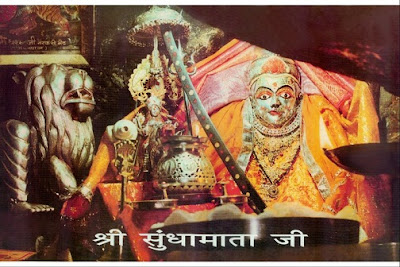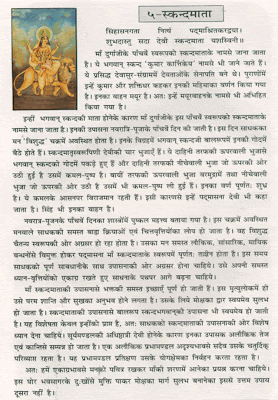 Mantra of 3 pinds ( Maa Vaishno Devi)
Mantra of 3 pinds ( Maa Vaishno Devi)
Kali mantra
Maha Kali is the fiercest form of Shakti or Durga, in the Hindu religion. Goddess Kali is the destroyer of evil. But Kali is also a compassionate mother who loves her sincere children. Kali is usually worshipped by tantriks to achieve "siddhis". Kali is the slayer of ego as well. Maha Kali Mantra forms part of the prayers offered to the goddess. Goddess Kali Mantra or Mantras for Maa Kali are given below:
"Atha Kalimantraye Sadyovaksiddhiprapyivan
Aravitairyah Sarvestam Prapnuvanti Jana Bhuvih"
"Savaruhaammahabhimaghoradanshtram Hasanmukhim Chaturbhujamkhadagmundavarabhayakaram Shivam
Mundamaladharamdevi Lolajihvandigambaram
Evam Sanchintayetkalim Shamasanalayavsinim"
"Kreem Kreem Kreem Hreem Hreem Hoom Hoom Dakshine Kalike
Kreem Kreem Kreem Hreem Hreem Hoom Hoom Swaha"
Laxmi mantra
Lakshmi is the goddess of wealth, luxury, beauty, power, generosity and auspiciousness. Maha Lakshmi is claimed to fulfill the promises of material, wealth and contentment. Goddess Lakshmi represents fortune, purity, courage and fertility. Maha Lakshmi Mantra forms the part of prayers offered to the lord. Lakshmi Mantra / Mantras of Goddess Lakshmi are as follows:
"Sarvagyay Sarvavarday Sarvadushtbhaydkree
Sarvadukhaharay Devi Mahalakshmi Namostutay"
Meaning: O Maa Lakshmi, you know everything, you grant favors to all, you are a terror to the evil and your art removes the misery of all. O propitious goddess, I surrender to you.
"Siddhi Buddhipraday Devi Bhuktimuktipradayeenee
Mantramurtay Sada Devi Mahalakshmi Namostutay"
Meaning: O divine goddess, you are the provider of success and intelligence. You are the benefactor of both worldly pleasure and freedom. The magical sound symbols-the Mantras, verily comprise their form with your grace. Propitious Mother, I surrender to you always.
"Aadhantarhitay Devi Aadhshakti Maheshwari
Yogajay Yogasambhutay Mahalakshmi Namostutay"
Meaning: O Ultimate Mother, your art is without beginning and end. Your art is the primal power. Your art comes out of Yogic practice and your art is evident through Yoga. Promising Mother, I surrender to you.
"Sthulsukshmay Maharodray Mahashakti Mahodray
Mahapaapharay Devi Mahalakshmi Namostutay"
Meaning: Goddess Lakshmi, your art in gross and subtle, is the most awful and powerful. Mother, you contain all things and you remove even the greatest sins. Auspicious Mother, I surrender to you.
"Padnaasanstithay Devi Parbrahmaswaroopeenee
Parmashree Jaganmatra Mahalakshmi Namostutay"
Meaning: Maa Lakshmi, you reside in the hearts of devotees and prove the art of the Supreme Brahman. You are mother of the universe with your supreme art. O Great Mother, I bow to you.
Saraswati mantra
Saraswati is the goddess of arts, music, knowledge, and wisdom in the Hindu religion. Goddess Sarasvati is said to possess the powers of speech, wisdom and learning. Sarsvati is regarded as the dispeller of chaos and confusion. Saraswati Mantra is an important mantra of the Hindus that is recited for higher knowledge and wisdom. In India, people pray to her for guidance and knowledge. Maa Sarasvati Mantra is as follows:
"Yaa Kundendu Tushaara Haaradhavalaa, Yaa Shubhravastraavritha
Yaa Veenavara Dandamanditakara, Yaa Shwetha Padmaasana
Yaa Brahmaachyutha Shankara Prabhritibhir Devaisadaa Vanditha
Saa Maam Paatu Saraswati Bhagavatee Nihshesha Jaadyaapaha"
Meaning: Goddess Saraswati is fair and beautiful like the jasmine-colored moon. Her white garland resembles the icy dew drops. She is decked in pure white attire. A white lotus serves as the throne of Maa Saraswati, on whose arm rests Veena. We pray Maha Saraswati, who is surrounded and respected by the Gods to bestow her blessings on us. May the goddess remove our lethargy and brighten our life with light of knowledge.

 हे माँ शरण में पड़ा हूँ
हे माँ शरण में पड़ा हूँ



























































